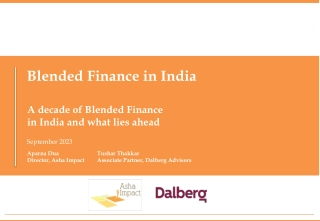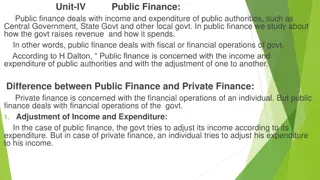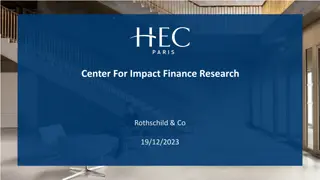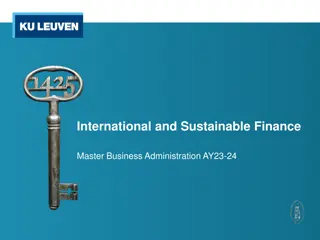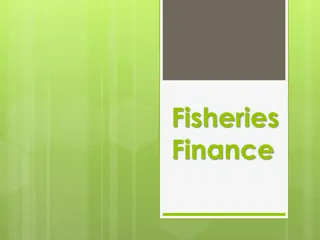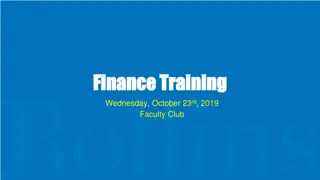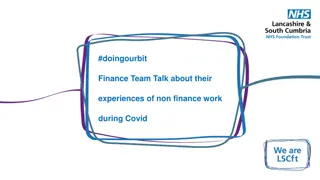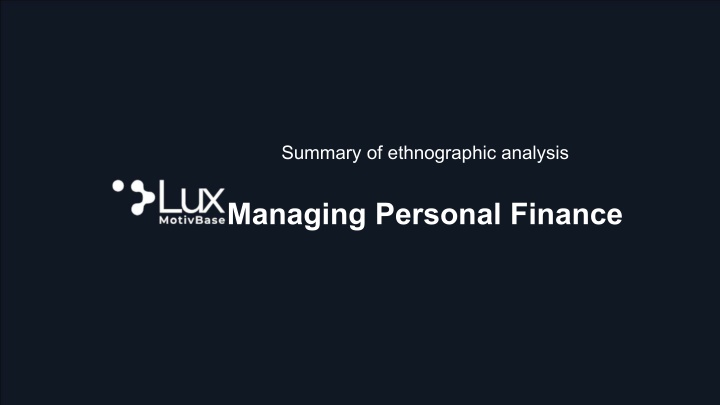
Consumer Behavior in Personal Finance Culture
Discover insights from ethnographic analysis and social media analytics on managing personal finance. Explore the motivations and demographics of consumers in the personal finance space. Gain a deeper understanding of the iceberg model of meaning and how it influences consumer decisions.
Download Presentation

Please find below an Image/Link to download the presentation.
The content on the website is provided AS IS for your information and personal use only. It may not be sold, licensed, or shared on other websites without obtaining consent from the author. If you encounter any issues during the download, it is possible that the publisher has removed the file from their server.
You are allowed to download the files provided on this website for personal or commercial use, subject to the condition that they are used lawfully. All files are the property of their respective owners.
The content on the website is provided AS IS for your information and personal use only. It may not be sold, licensed, or shared on other websites without obtaining consent from the author.
E N D
Presentation Transcript
Summary of ethnographic analysis Managing Personal Finance
SOCIAL MEDIA ANALYTICS Direct conversations about a topic SOCIAL MEDIA ANALYTICS Direct conversations about a topic METHODOLOGY Using machine intelligence + PhD Anthropologists, we conduct an observational study of consumer language to decode beliefs. SCALE Our engine scrapes data from (and studies) more than 20M consumers between the ages of 18-74 each monthNOTE: For global analysis, check our support portal for any limitations in data and representation. 2 ANTHROPOLOGY Direct and Indirect contextual conversations about a topic BY ANALYZING THE ASSOCIATIONS OF THE ASSOCIATIONS WE DISCOVER THE FORCES OF CHANGE REPRESENTATION It's 2024! We have no problem finding a representative sample of consumers between the ages of 18-74 in the western world. However, nothing is perfect. We do allow for approx 4% margin of error in demographic reporting.
Personal Finance How relevant is this space? Relevant to 120.8M people and growing by 10.6% over the next 12-24 months. 3 This culture is past its tipping point. This means consumers have a very clear sense of what they want in this space, and we must deliver against it.
Who is the consumer behind this culture? Motivations & Demographics Motivation They want to prove they're moving ahead in life. They are motivated to constantly feel a sense of progress in their lives, which is a measure of success. They want to feel like they're making day to day decisions that help their personal and professional lives change and evolve for the better. 52% of the audience falls into the following Family Type categories: couples without children, couples with children 47% of the audience falls into the following Age Bracket categories: 18-20, 35-44, 45-54 40% of the audience falls into the following Social Class categories: poor or near poor, lower middle class 4
Set up: Iceberg model of meaning This is our context. It's the part of the iceberg that s visible to us all. Consumers in your marketplace will have no trouble talking about this macroculture when asked questions about it. But their responses will tend to be logical and framed. MACROCULTURE implicit meaning line This is the most dangerous or valuable part of the culture where core beliefs are held. These core beliefs are hidden from plain sight and drive the consumer's decisions. People will often have a very difficult time articulating these beliefs and that is where observational research is key. CORE BELIEFS This is the least dangerous part of the culture. That is, these manifestations are current ways in which the consumer's beliefs manifest out in the market. This is also the part of the culture that changes the most because manifestations are behaviors that change and evolve quite often as new technologies and solutions are launched. CURRENT MANIFESTATIONS
These are the core beliefs that define the consumer in the context of Personal Finance 1. Maximizing Budgets Personal Finance = Ensuring they pay their bills on time, have an emergency fund, and enjoy life while avoiding financial stress. 3. Navigating Debt Personal Finance = Navigating financial pressures in a debt-ridden society. 5. Investing in Themselves Personal Finance = Pursuing long-term financial growth with a strategic investment plan. 6 EARLY CONSENSUS MAINSTREAM ACCEPTANCE ESTABLISHED IDEAS 2. Managing Credit Personal Finance = Securing upward mobility, so long as you have a stable income source. 4. Saving for the Future Personal Finance = Building and maintaining stability, security, and control over their financial future.
1. Maximizing Budgets Core Belief Core Belief Personal Finance = Ensuring they pay their bills on time, have an emergency fund, and enjoy life while avoiding financial stress. Current manifestations of this belief They talk about budgeting for fixed expenses and necessities, so they don't end up struggling with re-occurring expenses. They also mention the importance of setting aside some discretionary money in their monthly budget whenever possible so they can have some fun or enjoy life's little luxuries. Consumers recognize the importance of tracking their spending, so they know where their money is going and can create a budget to manage their expenses accordingly. 7 Consumers discuss the wisdom of setting money aside in their budget for unexpected expenses, so they avoid financial stress and reduce the risk of going into debt.
2. Managing Credit Core Belief Core Belief Personal Finance = Securing upward mobility, so long as you have a stable income source. Current manifestations of this belief Consumers discuss importance of building and maintaining a positive credit history to improve their creditworthiness and access better loan terms from lenders like banks. Consumers explore different mortgage options based on their credit scores, and set credit goals based to meet their goal of home ownership. Many consumers also express frustration that carrying a large student loan sabotages their ability to qualify for other lines of credit. 8 But they wish a strong credit history would help gigging consumers secure loans more, because they lack consistent verifiable income.
3. Navigating Debt Core Belief Core Belief Personal Finance = Navigating financial pressures in a debt-ridden society. Current manifestations of this belief Many express frustration about the impact of student loans, causing some to even regret pursuing education. Consumers stress responsible borrowing, highlighting the need to avoid predatory loans when they give advice to others. Some consumers decry that despite careful financial management, unforeseen medical expenses lead to life-altering debt. 9 Facing the challenges of managing unsecured revolving debt, consumers discuss issues like high credit card interest rates. They say stress arises when mortgage payments increase due to changes in the Fed's target rate, causing fear of missed payments, sales, or foreclosures.
4. Saving for the Future Core Belief Core Belief Personal Finance = Building and maintaining stability, security, and control over their financial future. Current manifestations of this belief Consumers mention that it's also crucial to have some liquid savings on hand for short-term needs and goals like a yearly vacation. Consumers actively save across diverse financial products to meet major life milestones in a structured manner. Despite these efforts, consumers express concerns about saving for retirement amid inflation and rising interest rates, impacting their daily survival and future financial security. 10 Consumers aim to secure a desired future while balancing shorter-term goals, recognizing the significance of adequate retirement contributions.
5. Investing in Themselves Core Belief Core Belief Personal Finance = Pursuing long-term financial growth with a strategic investment plan. Current manifestations of this belief They discuss prioritizing long-term investments in mutual funds and Exchange-Traded Funds (ETFs) that are considered safe but offer potential for substantial capital appreciation over time. Some consumers explore alternative investments because they believe having diverse investments and income streams is safer and increases their financial stability. Consumers mention the importance of professional advice, and many mention consulting with a financial advisor as their first step to setting up an investment strategy. 11 Consumers seek blue-chip stocks that provide regular dividend payments because they see them as a relatively stable source of passive income. Many consumers prioritize risk management during times of financial uncertainty and mention buying bonds to protect their capital.
Your action plan It's time for some homework Mid term opportunities Short term opportunities Personal Finance = Ensuring they pay Personal Finance = their bills on time, have an emergency Securing upward mobility, fund, and enjoy life while avoiding financial stress. Personal Finance = Navigating financial pressures in a debt-ridden society. Personal Finance = Building and maintaining stability, security, and control over their financial future. Personal Finance = Pursuing long-term financial growth with a strategic investment plan. Core beliefs DNA so long as you have a stable income source. Current manifestations of core belief Product DNA (In what ways is your product delivering against these beliefs?) - - - - - Brand DNA (In what ways is your brand delivering against these beliefs?) - - - - - Future manifestations of core belief Product DNA (In what ways could your product deliver against these beliefs?) - - - - - Brand DNA (In what ways could your brand deliver against these beliefs?) - - - - -




